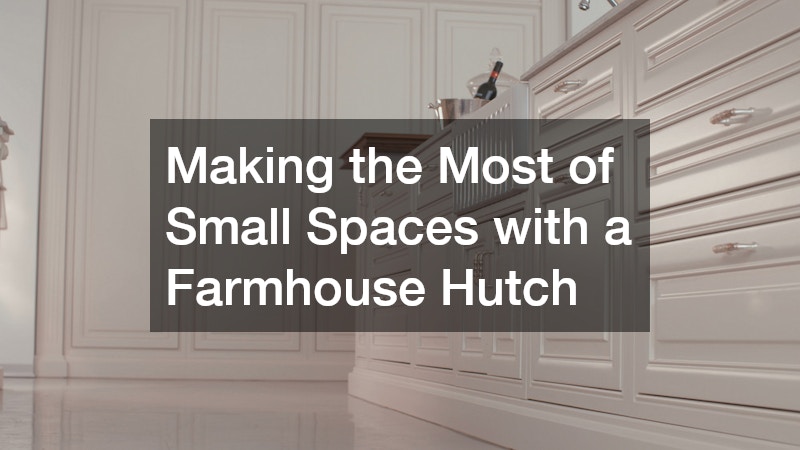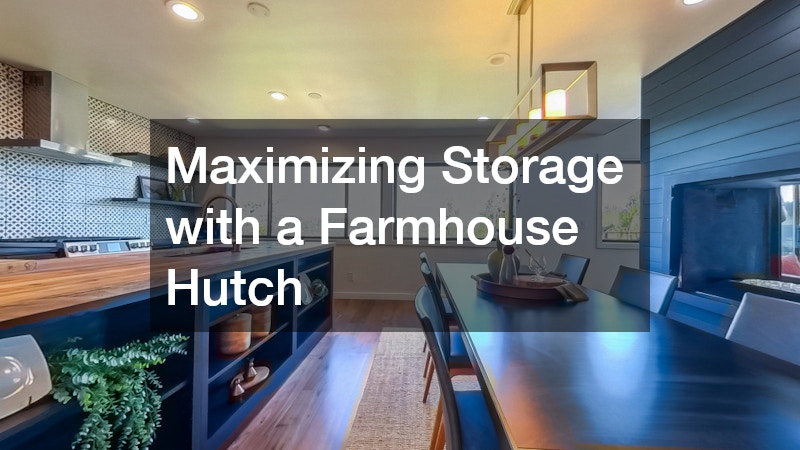Small spaces can be both charming and challenging to furnish. When every square foot counts, homeowners often seek furniture that combines practicality with style. The farmhouse hutch has become a favorite choice for those looking to maximize space while maintaining a warm, rustic aesthetic. Known for its combination of shelving, cabinetry, and versatile storage options, a farmhouse hutch adds visual depth and organizational functionality to even the smallest rooms.
Whether placed in cozy apartments, compact dining rooms, or narrow kitchen nooks, this timeless piece enhances storage and design. Beyond aesthetics, the farmhouse hutch serves as a reminder of traditional craftsmanship, blending effortlessly into both vintage and modern interiors. For homeowners considering new materials or custom cabinetry, connections with reliable plywood suppliers and guidance from a trusted garage cabinet company can also help ensure lasting durability and design consistency throughout the home.
In this guide, we’ll explore how to select, style, and maintain a farmhouse hutch to make the most of small spaces. From sustainable material choices to modern adaptations, readers will discover how this classic furniture piece continues to evolve — offering beauty, organization, and functionality without compromise.
What Is a Farmhouse Hutch?
The farmhouse hutch is a multifunctional storage unit that traditionally combines open shelving with enclosed cabinetry. Originating from 19th-century farmhouses, these pieces were designed to store dishes, linens, and food while keeping essentials within easy reach. Their sturdy build and rustic charm remain defining features today.
Historically, hutches were crafted from solid woods sourced through early versions of local plywood suppliers and cabinetmakers who emphasized longevity over decoration. Over time, the farmhouse hutch evolved into a statement of both practicality and craftsmanship, showcasing elements like distressed finishes, beadboard paneling, and simple metal hardware.
Modern farmhouse hutches reflect contemporary needs — often built to fit smaller living spaces, such as urban apartments. While vintage designs favored bulkier proportions, today’s versions incorporate lighter woods, compact dimensions, and flexible shelving to meet modern spatial limitations.
High-quality materials ensure structural integrity, similar to what you’d expect from a professional garage cabinet company. These suppliers understand that durability is key, especially when dealing with humidity, dust, or other contaminants that can affect wood longevity. In essence, the farmhouse hutch blends timeless charm with modern adaptability, making it an ideal fit for today’s smaller homes.
How to Choose the Right Farmhouse Hutch for Your Space
Choosing the perfect farmhouse hutch begins with accurate measurements. In small areas — especially compact kitchens or studio apartments — every inch matters. Before purchasing, measure wall height, width, and depth, factoring in clearance for doors, drawers, and surrounding walkways.
Next, consider style and aesthetic compatibility. The finish and design of your farmhouse hutch should coordinate with existing features such as slab countertops, flooring, and cabinetry. For example, light oak or white finishes create an airy effect, while darker stains lend warmth and contrast.
Storage needs also play a major role. If you frequently host gatherings or have a collection of dishes, opt for designs with adjustable shelving and deep drawers. Assessing quality and durability is equally important — craftsmanship from reputable sources, similar to what you’d find through trusted plywood suppliers or a garage cabinet company, ensures your investment lasts.
Lastly, evaluate your budget. Prices vary widely based on materials and size. A handmade hutch built from solid hardwoods will naturally cost more than a mass-produced version, but the quality difference can be significant. With careful consideration of form, function, and financial scope, you can select a farmhouse hutch that perfectly suits your space and lifestyle.
Placement Tips for a Farmhouse Hutch in Small Spaces
Placement can determine how effectively a farmhouse hutch enhances a small space. The goal is to achieve balance — ensuring the piece feels integrated rather than overwhelming. Ideal locations include dining rooms, kitchens, entryways, or even living rooms where wall space permits. In apartments, a compact hutch can serve as both storage and visual anchor, defining open-concept areas without crowding the layout.
Pay attention to natural light and traffic flow. Avoid blocking pathways or windows, and maintain sufficient clearance for cabinet doors to open fully. Integrating the hutch with existing furniture creates cohesion — for example, pairing it with dining tables featuring slab countertops or rustic wood finishes.
To enhance harmony, coordinate color tones and hardware materials across the space. This attention to detail ensures your farmhouse hutch complements surrounding textures rather than competes with them. Consulting interior professionals, including local plumbers or roofers when remodeling kitchens or utility areas, can also help address hidden elements like wall integrity and moisture resistance before installation.
By thoughtfully positioning your farmhouse hutch, you create a focal point that not only maximizes storage but also enhances the perceived spaciousness of your room.
Maximizing Storage with a Farmhouse Hutch
One of the farmhouse hutch’s greatest assets is its capacity to organize. To make the most of limited space, use upper shelves for frequently accessed items like plates, mugs, or decorative pieces. Lower cabinets can store heavier cookware, linens, or cleaning supplies. Adding baskets or fabric bins lined with microfibers can protect delicate items from dust and contaminants while maintaining a cohesive, clean look.
Adjustable shelves and pull-out drawers add flexibility, allowing for reconfiguration as storage needs evolve. Consider installing LED lighting within shelving to highlight décor and improve visibility in darker corners. Many homeowners even use small hutches as mini beverage stations or coffee bars, optimizing unused wall sections in apartments or studios.
For additional customization, working with a local garage cabinet company can help you design inserts or extensions that match existing cabinetry. Similarly, using quality materials from reliable plywood suppliers ensures structural strength and longevity. A well-organized farmhouse hutch not only reduces clutter but also makes everyday living more efficient, demonstrating how thoughtful design can enhance both form and function.
Styling a Farmhouse Hutch for Different Themes
The beauty of a farmhouse hutch lies in its versatility — it can adapt to nearly any décor style. For rustic or country-chic interiors, natural woods, weathered finishes, and antique accents capture authenticity. A coastal or nautical-inspired space may feature whitewashed tones and light blues to complement bright, airy surroundings.
In modern minimalist designs, clean lines and simple slab countertops pair seamlessly with sleek, neutral hutches. For those who enjoy eclectic or vintage combinations, mixing textures and displaying curated items creates a personalized aesthetic. Decorative accents like ceramic jars, woven baskets, and linen napkins maintain cohesion while highlighting craftsmanship.
Microfibers can be used as protective liners to preserve surface quality and reduce contaminants, particularly in open shelving areas. Professional stylists often recommend layering décor pieces at varying heights for visual depth. Meanwhile, homeowners undergoing broader renovations can coordinate their farmhouse hutch with input from roofers, local plumbers, or even a demolition contractor to ensure all utilities and finishes align harmoniously during redesign projects.
The result is a hutch that reflects personal taste while enhancing spatial flow, creating balance between functionality and visual appeal.
DIY and Upcycling Ideas for Farmhouse Hutches
DIY and upcycling have transformed the way homeowners approach home décor. Refurbishing an old farmhouse hutch can be a rewarding project that adds character while saving money. Start by cleaning surfaces thoroughly and sanding away old finishes. Use eco-friendly paints and stains to create a fresh appearance without introducing harsh contaminants into your living environment.
Adding distinctive hardware or reclaimed wood details sourced from plywood suppliers can give your hutch a unique identity. Some homeowners even repurpose old units into custom pantry organizers or compact workstations in small apartments. Applying durable coatings made from natural microfibers or sealants helps preserve finish quality and ease maintenance.
Collaborating with a garage cabinet company can also provide expert insight into design stability, ensuring drawers, shelves, and hinges operate smoothly. For extensive remodels, you might coordinate efforts with a demolition contractor to safely remove existing cabinetry or walls before repositioning the hutch.
Upcycling allows you to retain a sense of heritage while aligning your furniture with contemporary sustainability goals — a balance that defines the farmhouse aesthetic.
Maintenance and Care for Your Farmhouse Hutch
Proper maintenance ensures that your farmhouse hutch retains its charm and function for years. Regular dusting with microfibers prevents buildup of grime and contaminants that can damage finishes. Use mild wood cleaners and avoid excessive moisture, particularly in humid climates or near kitchens and bathrooms.
For surface protection, place mats or coasters beneath decorative items to prevent scratches and stains. Refrain from overloading shelves, as excessive weight may cause warping — especially in units not reinforced by strong plywood suppliers or solid-core panels.
Occasional refinishing may be needed to address wear, fading, or minor cracks. Homeowners who prefer professional results can consult local carpenters or restoration specialists. When moisture issues arise due to plumbing leaks or humidity, consulting local plumbers promptly prevents further damage. Similarly, if the hutch is near an exterior wall, coordination with roofers ensures proper insulation and leak prevention.
By following simple care routines, your farmhouse hutch remains a reliable, visually appealing feature that enhances storage and ambiance without demanding constant upkeep.
Where to Buy the Best Farmhouse Hutches
The modern market offers a wide variety of farmhouse hutches, ranging from handcrafted antiques to factory-produced models. Online retailers provide convenience and diverse styles, while physical furniture stores allow you to inspect materials and craftsmanship firsthand.
When comparing options, consider whether you prefer custom-made or pre-built units. A garage cabinet company can design bespoke pieces tailored to your exact measurements and finishes, often using materials sourced from local plywood suppliers for superior quality. Antique dealers may offer one-of-a-kind pieces that carry historical significance, while big-box retailers cater to affordability and accessibility.
Reading reviews and seeking recommendations helps gauge quality and reliability. Pay attention to details like joinery, hardware, and finishes to ensure longevity — particularly important in apartments where space optimization matters most.
Before installation, coordinate with local plumbers or roofers if structural adjustments are required during remodeling. A carefully selected farmhouse hutch not only enhances small-space organization but also represents an investment in timeless craftsmanship and home comfort.
The Environmental Impact of Farmhouse Hutch Materials
Sustainability has become a defining factor in furniture design. When choosing a farmhouse hutch, it’s worth considering where and how materials are sourced. Reclaimed wood, eco-friendly paints, and responsibly harvested timber from certified plywood suppliers help reduce environmental impact.
Some manufacturers prioritize finishes with minimal volatile organic compounds (VOCs), which reduces airborne contaminants in indoor environments — especially beneficial for smaller apartments with limited ventilation. Opting for durable, long-lasting materials also minimizes waste, as high-quality hutches often outlive cheaper alternatives.
If you plan a full renovation, coordination with a demolition contractor ensures old materials are safely removed and recycled. Additionally, many homeowners complement sustainable furniture choices with energy-efficient upgrades such as improved insulation or water heater repair, reinforcing eco-conscious living.
By choosing environmentally responsible options, you align the timeless appeal of the farmhouse hutch with modern sustainability standards — creating a space that’s beautiful, practical, and mindful of its ecological footprint.
Personalizing Your Farmhouse Hutch
Personal touches bring a farmhouse hutch to life. Displaying family memorabilia, heirlooms, or framed photos infuses warmth and personality into the piece. Seasonal décor changes — such as floral arrangements in spring or rustic tableware in autumn — allow the hutch to evolve throughout the year.
Adding art, small sculptures, or curated collectibles can make even small apartments feel more expressive. Integrate textures such as linens, ceramics, or microfibers to create depth while maintaining softness. To highlight contrast, balance neutral tones with subtle color accents or metallic details that complement slab countertops or flooring finishes.
For those undertaking larger remodels, collaboration with roofers or local plumbers may be necessary if repositioning lighting or water fixtures near the hutch. Additionally, consultation with a garage cabinet company can help match cabinetry style across the home for aesthetic consistency.
Ultimately, personalization transforms a farmhouse hutch from simple storage into a meaningful centerpiece — one that tells your story while enhancing the functionality of your space.
A farmhouse hutch represents far more than a decorative storage piece — it’s a fusion of tradition, craftsmanship, and adaptability. In small spaces such as modern apartments, it offers a way to combine visual appeal with efficient organization. By selecting the right materials, placement, and finishes, homeowners can create an environment that feels open and intentional, rather than crowded.
Partnering with reputable plywood suppliers or a skilled garage cabinet company ensures structural integrity and long-term satisfaction. Attention to maintenance — including addressing contaminants, scheduling water heater repair when needed, and consulting local plumbers or roofers during renovations — helps preserve both functionality and appearance. Even demolition contractor services may play a role in preparing spaces for new installations, ensuring seamless transitions during remodels.
Ultimately, making the most of small spaces with a farmhouse hutch is about balance — blending style with utility, sustainability with strength, and heritage with modern living. With careful planning and creativity, this timeless furniture piece can transform any compact room into a welcoming, efficient, and beautifully organized home.





